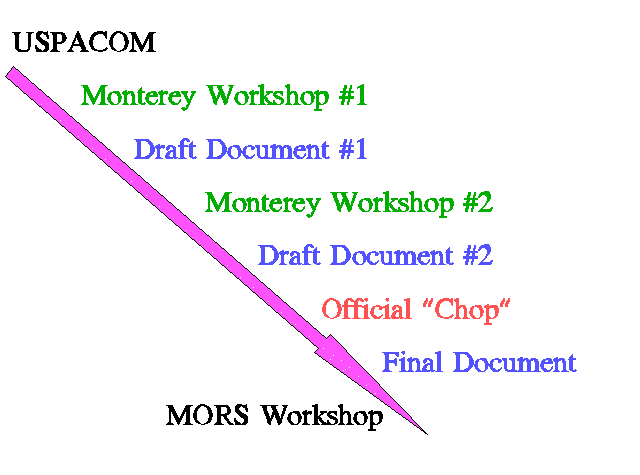
| Project Metadata | Keywords | |||||||||||||||||||||||||||||||||||||||||||||||||||||||||||||||||||||||||||||||||||||||||||||||||||||
|
|
The past several years have seen an increasing recognition of the need for analysis tools to support planning and execution of military OOTWs. Analysis tools to support decision-making for large-scale military operations (such as major regional contingencies) are relatively mature. In contrast, OOTW analysis tools are embryonic or non-existent. Because the U.S. military involvement in OOTWs is expected to be increasingly frequent during the post-Cold-War era, USPACOM has argued that development of OOTW analysis tools should receive higher priority than continued enhancement of analysis tools for large-scale military operations.
USPACOM instituted a project to define the requirements for analysis tools to support OOTWs. These requirements would then influence the development of OOTW analysis capabilities within the Joint Warfare System (JWARS) [external], which is being developed under the sponsorship of the Office of the Secretary of Defense (Program Analysis & Evaluation). Because current plans for JWARS development do not call for OOTW analysis capabilities to be incorporated for several years, the project would also identify opportunities for developing interim OOTW analysis capabilities, including exploratory tools for possible incorporation into JWARS.
Department of Defense organizational participants and reviewers of the USPACOM project are shown in Table 1.
Table 1. DOD Approving Organizations
| US Atlantic Command (USACOM) |
| US Central Command (USCENTCOM) |
| US European Command (USEUCOM) |
| US Pacific Command (USPACOM) |
| US Special Operations Command (USSOCOM) |
| US Southern Command (USSOUTHCOM) |
| Office of the Secretary of Defense Program Analysis and Evaluation (OSD PA&E) |
| The Joint Staff/J-8 |
| US Air Force |
| US Army |
| US Marine Corps |
| US Navy |
Figure 1 capsulizes the sequence of events over the duration of the project. USPACOM initiated the process and sponsored a workshop held at the Naval Postgraduate School in Monterey in February 1996. This workshop was attended by representatives of the Office of the Secretary of Defense, the Joint Staff, the Unified Commands, the Services, and numerous other organizations. This author wrote a draft document based on that workshop, other conferences on OOTWs, and research of the literature on OOTWs. USPACOM sponsored a second Monterey workshop in September 1996 to review and extend the draft document. This workshop identified and categorized the many types of operations that can be considered operations other than war; examined the attributes of different kinds of OOTWs; and identified similarities and differences of U.S. military tasks that must be performed in OOTWs. The draft document was refined, creating a second draft, and USPACOM circulated the result to the Commanders in Chief (CINCs), the Services, Office of the Secretary of Defense (OSD), and J-8.

Figure 1. Project Overview
The final document provided the basis for the MORS workshop, which created more detailed plans for accomplishing the requirements. This process, and the detailed results obtained, are fully described in the publications listed in the metadata, above. The details can also be found on the OOTW Tool Home Page.
If you arrived here using a keyword shortcut, you may use your browser's "back" key to return to the keyword distribution page.
Return to Hartley's Projects Page